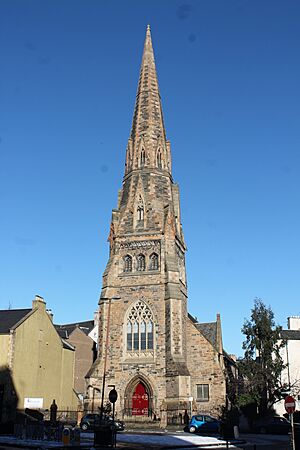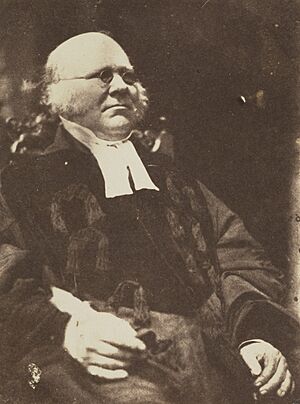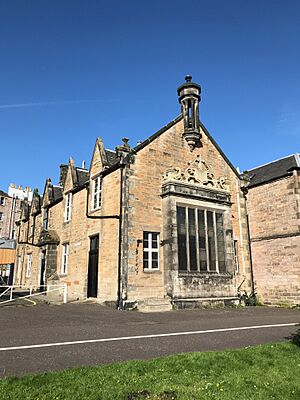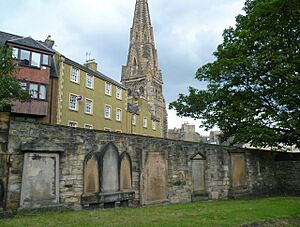St Andrew's Orthodox Church, Edinburgh facts for kids
Quick facts for kids St Andrew's Orthodox Church |
|
|---|---|
 |
|
| 55°56′37″N 3°11′07″W / 55.94361°N 3.18528°W | |
| Location | Edinburgh, Scotland |
| Country | United Kingdom |
| Language(s) | English Slavonic Romanian Greek |
| Denomination | Greek Orthodox |
| Previous denomination | Church of Scotland (1756–1969) |
| History | |
| Former name(s) | St Cuthbert's Chapel of Ease (1756–1834) Buccleuch Parish Church (1834–1969) |
| Dedication | Saint Andrew |
| Events | 1969: Buccleuch Parish Church closed and building sold to University of Edinburgh 2013: Building purchased by Orthodox Community of St Andrew |
| Architecture | |
| Functional status | Active |
| Style | Scottish Vernacular Gothic revival |
| Groundbreaking | 1755 |
| Completed | 1756 |
| Construction cost | £642 (£66.7 thousand in 2021) |
| Administration | |
| Archdiocese | Archdiocese of Thyateira and Great Britain |
St Andrew's Orthodox Church is a special church in Edinburgh, Scotland. It's an Orthodox church, which is a type of Christian church. The community started in 1948. Since 2013, they have used this building. Before that, it was called Buccleuch Parish Church. It was first built in 1756 and closed in 1969.
In the 1700s, the area around Edinburgh was growing. A church called St Cuthbert's needed a smaller church to help serve everyone. So, in 1756, a new church opened. It was called St Cuthbert's Chapel of Ease. A "chapel of ease" was a church built to make it easier for people to attend services if their main church was too far away.
This chapel became a full parish church in 1834. It was then known as Buccleuch Parish Church. In 1839, it even started a school nearby. A big event called the Disruption of 1843 affected many churches in Scotland. This church also faced challenges, but it was helped by Archibald Charteris and a university group.
By the mid-1900s, fewer people lived in the area. So, in 1969, Buccleuch Parish Church joined with other churches. The building was then sold to the University of Edinburgh. The university used it to store furniture for many years.
The Orthodox Community of St Andrew began in 1948. It was started by a Russian chaplain named Archpriest John Sotnikov. Later, under Maitland Moir, the community moved into the old Buccleuch Parish School in 2003. They bought the main Buccleuch Parish Church building in 2013.
The church building is simple but has a cross shape. It was changed a lot in 1866 to look more Gothic. It has been a protected building since 2007. Famous people like Thomas Blacklock and Deacon Brodie are buried in the churchyard outside.
Contents
History of Buccleuch Parish Church
How the Church Started
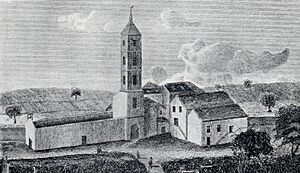
In the mid-1700s, the West Kirk Parish was very large. It covered most of the area around Edinburgh. Many people lived in the Southside, south of the Old Town. The West Kirk decided to build a "chapel of ease" to help these people.
They started collecting money in 1754. They bought land near the Boroughloch. People who gave £5 or more could help choose the church's minister. Building chapels of ease became common later in Scotland. But St Cuthbert's Chapel of Ease was one of the first. It was built for 1,200 people and cost about £642.
Early Years of the Chapel
The chapel opened in January 1756. At first, ministers from the West Kirk took turns preaching there. But this was too much work. So, in 1758, James Roy became the first dedicated minister. When it opened, the church was in a mostly rural area. But soon, fancy homes were built nearby. These included George Square and Buccleuch Place.
The church attracted wealthy people. Many important city figures attended. Later, in 1810, a new section was added to the church. This helped make space for more people.
In 1834, the church officially became a parish church. It was named Buccleuch Parish Church. In 1839, the Buccleuch Parish School opened. It was in a building facing the Meadows.
Changes and Challenges
In 1843, a big event called the Disruption of 1843 happened in the Church of Scotland. Many ministers and church members left to form the Free Church. The minister of Buccleuch, Patrick Clason, led many people from his church to join the Free Church.
This made it hard for Buccleuch Parish Church to continue. But a group called the Edinburgh University Missionary Association helped. They used the church for their mission work. Soon, the church had a large and active group of members again. By 1857, it could afford a full-time minister.
From 1863 to 1875, the church was renovated. It was updated in the Gothic style. A choir was started, and a musical instrument called a harmonium was bought. Later, in 1899, a permanent pipe organ was installed.
The 1900s
The church continued to grow in the early 1900s. By 1911, it had many groups for young people and missionaries. In 1928, the church had its largest number of members, over 2,000.
However, by the mid-1900s, fewer people lived in the Southside area. Many members moved away. The University of Edinburgh also started expanding in the area. By 1960, the number of members had dropped to 824.
In the 1950s, the church halls were used for a mothers' clinic and for plays during the Fringe Festival. The church also started sharing summer services with other local churches.
In 1969, Buccleuch Parish Church joined with two other churches. The new combined church was called Kirk o' Field. It met in a different building. The Buccleuch church building was then sold to the University of Edinburgh. They used it as a furniture store.
Ministers of the Church
Here are some of the ministers who served the church:
- 1758–1765 James Roy
- 1766–1808 John Touch
- 1813–1821 Henry Grey
- 1821–1824 Robert Gordon
- 1824–1843 Patrick Clason
- 1844–1851 Henry Rutherford
- 1857–1863 Alexander McLaren
- 1864–1875 Finlay Mathieson
- 1875–1881 John Young Scott
- 1882–1901 John Campbell
- 1901–1907 David Andrew Rollo
- 1908–1913 James Edward Houston
- 1913–1923 Neil MacLeod Ross
- 1924–1928 John Spence Ewen
- 1929–1964 William Gemmell Mitchell
- 1965–1968 James Sinclair Cormack
St Andrew's Orthodox Church Today
An Orthodox chaplaincy (a place for religious services) started in Edinburgh in 1948. It was led by Archpriest John Sotnikov, a Russian chaplain. At first, most people attending were Polish soldiers. Services were in Slavonic.
In 1984, Maitland Moir took over. He was a Scottish person who had converted to Orthodoxy. Under him, English became the main language for services.
In 2003, the community bought the old Buccleuch Parish School building. They moved from their previous location. By 2012, about 250 people attended services regularly. The community had grown too big for the school building. So, they put it up for sale that same year.
The community then bought the former Buccleuch Parish Church. The purchase was completed on April 17, 2013. This was the same day Maitland Moir passed away at 88 years old.
Since it started, the community has been part of the Archdiocese of Thyateira. Services are mostly in English. But the church also has services in Greek, Slavonic, and Romanian.
The Church Building
What the Building Looks Like
This church is the oldest religious building still standing in Edinburgh's Southside. Today, it looks like a simple Gothic building with a cross shape. In the northeast corner, there is a short tower with a small, pointed spire. The outside walls are made of rough stone with smoother stone around the windows and doors.
The front of the church, facing east, is balanced. It has a small entrance porch with windows on either side. Above the porch, there's a stone that says "ERECTED 1755: RESTORED 1866". Above this, there are three pointed windows and a clock. The south side of the church has a curved section. The north side has a square section.
Inside, the building has two floors. Many of the original features are still there. These include the pulpit (where the minister preaches), the organ loft, and the galleries. There are also wooden screens with glass panels near the entrance. These screens have fancy door handles and stained-glass pictures.
How the Building Changed Over Time
When it was built in 1755, the church was a plain, local style building. One writer in 1756 called it "a plain genteel building." But another writer in 1880 described it as "a hideous and unpretending structure" before its 1866 renovation.
In 1763, a three-part bell tower was added to the front. A bell from St Cuthbert's was put in the tower in 1791. This bell was made in 1700. Below the bell tower was a porch that led directly to the street.
In 1810, a new section and gallery were added to the north side of the church. This helped make more room for the growing number of people.
The church was renovated in 1866 by David MacGibbon. The outside was changed to the Gothic style. A clock was put on the east wall. The old tower was removed and replaced with a short spire on the north side. The spire originally had a tall top, but this was removed in the early 1900s. A curved section was also added to the south side.
Stained glass windows were installed. One window was given by the Marquess of Bute to remember an ancestor. Another window remembers Alexander Adam. In 1899, a two-manual organ was added. After the church was no longer used for worship, the inside was divided into two floors. The building became a protected historic building on October 10, 2007.
The church once had two tall black boards from the late 1700s. They showed the Lord's Prayer, the Creed, and the Ten Commandments in gold letters. In 1950, these boards were given to a nearby church, where they still are today.
Buccleuch Kirkyard
The land around the church was opened for burials in June 1763. On June 25, 1764, an Episcopal bishop officially blessed the churchyard. This was unusual, and the church elders who asked for it were told off by the local church leaders. The land was not officially given to the West Kirk until 1768.
The churchyard used to have a windmill. This windmill pumped water from the Boroughloch to the town for brewers. The windmill was taken down around the time the chapel was built. But it gave its name to Windmill Street and Windmill Lane, which are next to the churchyard.
Many people are buried in the churchyard. These include the doctor Andrew Duncan, the writer David Herd, the educator Alexander Adam, and the poet Thomas Blacklock. The famous cabinet maker and criminal Deacon Brodie is buried against the north wall. A plaque on the wall remembers Alison Cockburn, who wrote the song Flowers of the Forest. Charles Darwin, the uncle of the famous scientist Charles Darwin, is also buried here.
By 1820, the churchyard was very full. No new burial plots were made available. Instead, St Cuthbert's Parish opened a new burial ground in Newington. In 1904, the church bought a large metal hall from Glasgow. They put it in the churchyard. This meant moving all the gravestones from the middle of the churchyard to the boundary wall.
After the hall opened, the church leaders thought about renting it out for roller skating. But the idea of people roller skating over graves caused a lot of debate. People wrote letters to local newspapers complaining. So, the church quickly dropped the idea.


